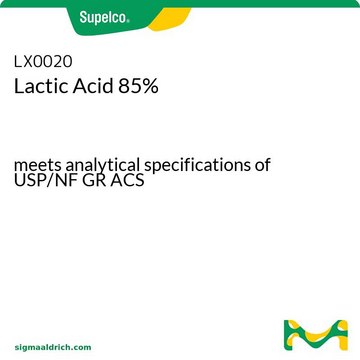W261106
Lactic acid
85%, FCC
Synonym(s):
DL-Lactic acid, 2-Hydroxypropionic acid
About This Item
Halal
Kosher
Recommended Products
grade
Fragrance grade
Halal
Kosher
Quality Level
Agency
follows IFRA guidelines
reg. compliance
EU Regulation 1223/2009
FCC
FDA 21 CFR 117
FDA 21 CFR 184.1061
Assay
85%
form
viscous liquid
refractive index
n20/D 1.425 (lit.)
pH
2
bp
122 °C/15 mmHg (lit.)
density
1.209 g/mL at 25 °C (lit.)
anion traces
sulfate (SO42-): ≤0.25%
cation traces
As: ≤3 ppm
Cd: ≤1 ppm
Fe: ≤10.0 ppm
Hg: ≤1 ppm
Pb: ≤0.5 ppm
application(s)
flavors and fragrances
Documentation
see Safety & Documentation for available documents
food allergen
no known allergens
fragrance allergen
no known allergens
Organoleptic
odorless
SMILES string
CC(O)C(O)=O
InChI
1S/C3H6O3/c1-2(4)3(5)6/h2,4H,1H3,(H,5,6)
InChI key
JVTAAEKCZFNVCJ-UHFFFAOYSA-N
Looking for similar products? Visit Product Comparison Guide
General description
Disclaimer
Signal Word
Danger
Hazard Statements
Precautionary Statements
Hazard Classifications
Eye Dam. 1 - Skin Corr. 1C
Supplementary Hazards
Storage Class Code
8A - Combustible corrosive hazardous materials
WGK
WGK 1
Flash Point(F)
235.4 °F - closed cup
Flash Point(C)
113 °C - closed cup
Personal Protective Equipment
Choose from one of the most recent versions:
Already Own This Product?
Find documentation for the products that you have recently purchased in the Document Library.
Customers Also Viewed
Our team of scientists has experience in all areas of research including Life Science, Material Science, Chemical Synthesis, Chromatography, Analytical and many others.
Contact Technical Service




